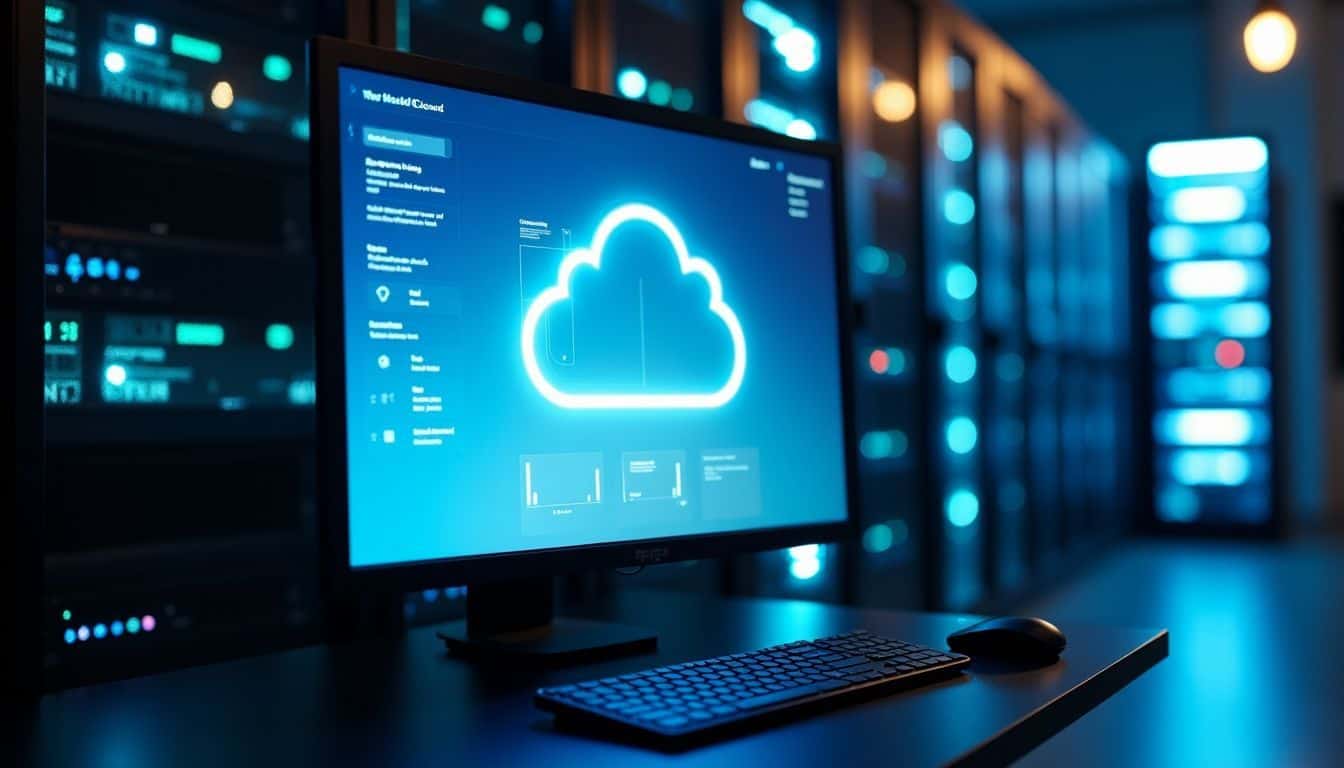Are you worried about moving your business systems to the cloud by 2025? Many companies struggle with what is cloud migration and modernization, and how to make it work. Studies show that 94% of businesses now use cloud services to stay ahead of their competition.
This guide will show you the exact steps to move and upgrade your systems for the cloud age. Get ready to future-proof your business!
Key Takeaways
Cloud migration moves apps and data to cloud servers, while modernization rebuilds them with new features – 94% of businesses now use cloud services to stay competitive.
Companies can choose from three migration types: rehosting (quick lift-and-shift), replatforming (minor tweaks), or refactoring (complete rebuild) – each offering different levels of cloud benefits and costs.
Application modernization breaks down large programs into microservices, leading to 28% higher revenue growth and 39% lower IT costs through smart updates and cloud-native features.
Security and compliance remain crucial during cloud moves, requiring strict controls like encryption and following rules like HIPAA, GDPR, and PCI DSS to protect business data.
The key difference between migration and modernization is time and depth – migration takes weeks to months with minimal changes, while modernization takes months to years but offers better performance and scalability.
Table of Contents
Defining Cloud Migration and Modernization

Moving your apps and data to the cloud is like packing up your house and moving to a smart home with cool new gadgets. Cloud migration shifts your old tech to modern platforms, while cloud modernization gives those apps superpowers through new features like AI and automation.
What is Cloud Migration?
 Cloud migration means shifting your apps and data from local computers to cloud servers. Think of it as packing up your digital stuff and moving it to a new online home. I’ve helped many companies lift-and-shift their monolithic apps to AWS EC2 instances, and it’s like relocating a whole house without changing its layout.
Cloud migration means shifting your apps and data from local computers to cloud servers. Think of it as packing up your digital stuff and moving it to a new online home. I’ve helped many companies lift-and-shift their monolithic apps to AWS EC2 instances, and it’s like relocating a whole house without changing its layout.
The process needs careful planning, just like any big move.
Tech teams often start with basic steps: picking the right cloud service, setting up security rules, and testing everything works. Last month, I moved a large Ubuntu 20.04 system to AWS without changing its core structure.
Cloud migration is not about moving data – it’s about moving your business forward.
The app kept running as usual, but now it lives in the cloud. Public clouds like AWS, private clouds, or a mix of both (hybrid) give different options for your move. The key is keeping your systems running while making the switch.
What is Cloud Modernization?

Moving beyond basic migration, cloud modernization takes your tech setup to the next level.
This process rebuilds applications to squeeze every drop of value from cloud-native features. Think of it as giving your old car a complete makeover with a new engine, smart tech, and better fuel efficiency.
Modernization breaks down bulky monolithic applications into smaller, nimble microservices. These tiny pieces work together smoothly through containers and Kubernetes clusters.
The real magic happens in how modernized apps use cloud resources. Your applications become resource-smart, scaling up or down based on actual needs. Picture a rubber band that stretches perfectly to fit whatever you need.
This approach makes apps easier to manage and update. Many companies split their big programs into microservices first, then set up special container environments to host them. This setup lets tech teams work faster and smarter while keeping costs in check.
Types of Cloud Migration

Moving your apps to the cloud isn’t a one-size-fits-all deal. You can pick from three main ways to shift your stuff to the cloud – each with its own pros and cons for your tech stack and budget.
Rehosting

Rehosting, nicknamed “lift and shift,” stands as the fastest path to cloud migration. Companies pick up their apps and drop them into the cloud without changing any code. Think of it like moving your furniture from one house to another – you’re not repainting or fixing anything, just relocating.
This method belongs to Gartner’s famous “5 Rs” model for cloud shifts.
Speed wins in cloud migration, and rehosting is the express lane.
NetApp Cloud Volumes ONTAP
It’s like having a sports car but never pushing it past 30 mph – you’re missing out on the real power under the hood.
Replatforming
 Replatforming moves your apps to the cloud with small tweaks. Think of it as giving your apps a fresh coat of paint without tearing down the whole house. Cloud providers like AWS make this process smooth by letting you shift applications while keeping their core structure intact.
Replatforming moves your apps to the cloud with small tweaks. Think of it as giving your apps a fresh coat of paint without tearing down the whole house. Cloud providers like AWS make this process smooth by letting you shift applications while keeping their core structure intact.
Your apps run better in the cloud, and you spend less money than a complete rebuild would cost.
Moving to cloud infrastructure through replatforming brings quick wins for tech teams. You get faster performance and better scalability without starting from scratch. The catch? You might miss out on some cool cloud-native features that could make your apps even better.
Still, for many companies, this middle-ground approach hits the sweet spot between cost and benefit.
Refactoring

Refactoring stands as the most complex yet rewarding cloud migration method. I’ve seen countless teams transform their legacy apps into modern cloud powerhouses through smart refactoring.
This process rebuilds existing applications from scratch to work better in the cloud. Teams break down monolithic systems into smaller, independent microservices. Each piece runs on its own, making updates easier and faster.
Cloud-native technologies shine during refactoring projects. My teams use containerization and serverless functions to boost app performance. We split big databases into NoSQL solutions for better speed.
The process takes more time than simple lift-and-shift moves, but the payoff rocks. Apps become more scalable, cost less to run, and adapt faster to business needs. DevOps practices fit naturally here, as teams can automate testing and deployment of these modernized components.
Types of Cloud Modernization

Cloud modernization splits into two main paths: making apps better and fixing up the tech backbone. Companies can pick either path or mix them both to match what they need right now.
Application Modernization

Application modernization turns old software into modern, cloud-ready apps. Companies see a 28% boost in revenue growth through smart updates of their existing programs. The process breaks down large applications into smaller, independent microservices.
These microservices run faster and cost less to maintain than traditional programs. Cybersecurity professionals play a key role in keeping these modernized apps safe.
Technical teams can now use serverless computing and DevSecOps practices to speed up app delivery. Machine learning and analytics help spot areas that need fixes. The shift to modern apps leads to a 39% drop in IT costs.
Modernization isn’t just about moving to the cloud – it’s about making your apps work smarter, not harder.
Platform as a Service (PaaS) tools make it easy to test and deploy new features. Companies use infrastructure as code to manage their entire app portfolio with less manual work.
Infrastructure Modernization
 Infrastructure modernization focuses on updating old data centers and computing systems to match today’s cloud tech needs. Companies must replace outdated hardware, upgrade network components, and shift to virtual machines for better computing power.
Infrastructure modernization focuses on updating old data centers and computing systems to match today’s cloud tech needs. Companies must replace outdated hardware, upgrade network components, and shift to virtual machines for better computing power.
A retail bank proved this works – they boosted their speed and cut costs by moving their core systems to cloud platforms.
Cloud service providers like AWS offer tools to modernize aging IT setups through serverless architecture and microservices. These tools help businesses handle more data, support IoT devices, and run faster operations without buying expensive hardware.
The next section shows how migration differs from modernization in key ways.
Key Differences Between Migration and Modernization

Cloud migration and modernization have distinct differences in their approaches, goals, and outcomes. Here are the key differences:
| Aspect | Cloud Migration | Cloud Modernization |
|---|---|---|
| Code Changes | Minimal to zero code modifications | Major code restructuring and updates |
| Time Investment | Quick wins – weeks to months | Long-term project – months to years |
| Application Architecture | Stays the same as on-premises | Transforms into cloud-native design |
| Resource Utilization | Similar to on-premises patterns | Optimized for cloud efficiency |
| Cost Model | Basic cloud cost savings | Deep cost optimizations possible |
| Performance Impact | Minimal changes in speed | Significant performance boost |
| Scalability | Limited by original design | Built-in elastic scaling |
| Risk Level | Lower risk, familiar setup | Higher risk, new architecture |
| Team Skills | Basic cloud knowledge needed | Advanced cloud expertise required |
| Business Impact | Quick return to operations | Long-term competitive edge |
Best Practices for Cloud Migration and Modernization

Best practices for cloud migration and modernization focus on smart planning, risk control, and strong security – want to learn the exact steps to make your 2025 cloud move a success? Read on!
Building a Business Case
A solid business case forms the backbone of any cloud project. Your tech leaders need clear numbers and facts about costs, benefits, and risks. Start by mapping your current IT spending against projected cloud costs.
Pull data from your existing systems to show where you waste money on outdated tech. Include hard metrics about how cloud solutions will boost your team’s output and cut expenses.
Money talks – so focus your pitch on the bottom line. Show exact figures for hardware savings, reduced maintenance fees, and lower energy bills. Highlight how cloud tools can speed up your development cycles by 30-40%.
Paint a clear picture of risks, too – like temporary service gaps or staff training needs. Your fellow geeks will appreciate straight talk about technical debt and legacy system headaches.
Back everything with solid KPIs and real-world examples from similar companies who made the switch.
Prioritizing Security and Compliance
Building a strong business case leads straight into security and compliance – two pillars you can’t ignore in cloud computing services. Security controls must protect your data at every step.
Your cloud migration needs access controls, encryption, and intrusion detection systems. These safety nets keep your data safe from threats.
Cloud technology demands strict compliance with HIPAA, GDPR, and PCI DSS rules. Regular security checks through audits and penetration testing spot weak points fast. Many fintech companies use automated tools like Datamotive EasyMigrate to meet these rules.
This tool handles security across different cloud platforms, making compliance easier. The right privacy measures protect both your business value and customer trust.
People Also Ask
What exactly is cloud migration and modernization in 2025?
Cloud migration means moving your business process and data warehouses to cloud-based systems like Amazon Web Services (AWS). It’s like giving your old house a complete makeover with new technologies and microservices architecture.
How do I know if my company needs cloud transformation?
Start with a clear objective and value proposition. Look at your legacy applications, operating system, and current expenditure. If you’re falling behind in productivity or losing competitive advantage, it’s time to jump on the cloud bandwagon.
What’s the best strategy for moving to the cloud?
Begin with risk assessment and evaluation. Create a minimum viable product first. Consider hybrid cloud options and modern tools like MLOps and Hadoop. Remember, good governance and change management make the journey smoother.
Will cloud technologies really help my business grow?
Yes! Cloud hosting boosts reliability and innovation. It’s not just about storing files anymore. Modern cloud solutions, including generative AI and emerging technologies, can transform your business strategies completely.
How do I pick between different CSPs (Cloud Service Providers)?
Research their datacenter locations, runtimes, and peer-to-peer capabilities. Compare prices and features. Think about what matches your needs best. Don’t just follow the crowd – pick what works for your specific situation.
What’s the biggest challenge in cloud migration?
The biggest hurdle isn’t technical – it’s mindset. Getting your team ready for change takes work. You need clear information sharing and strong leadership. Think of it as moving to a new city – it takes time to adjust.
References
https://www.cloudzero.com/blog/cloud-migration/
https://www.techtarget.com/searchcloudcomputing/definition/cloud-migration (2024-12-13)
https://www.techtarget.com/searchcloudcomputing/definition/cloud-modernization
https://bluexp.netapp.com/blog/cvo-blg-cloud-migration-approach-rehost-refactor-or-replatform
https://www.mertech.com/blog/cloud-application-modernization-explained (2024-02-27)
https://jfrog.com/devops-tools/article/cloud-migration-vs-cloud-modernization/ (2023-03-31)
https://cloud.folio3.com/blog/cloud-migration-and-modernization/
https://www.techtarget.com/searchcloudcomputing/tip/How-to-build-a-business-case-for-cloud-migration (2024-11-15)
https://www.teradata.com/insights/cloud-data-analytics/build-business-case-for-cloud-modernization
